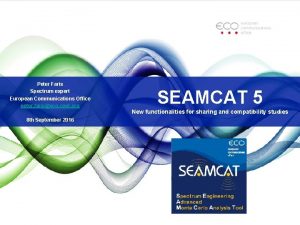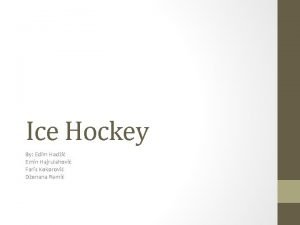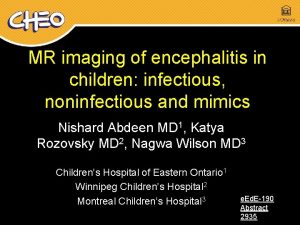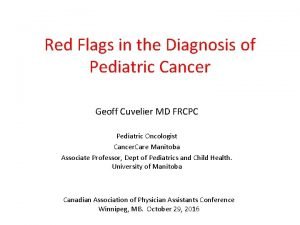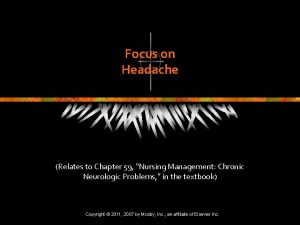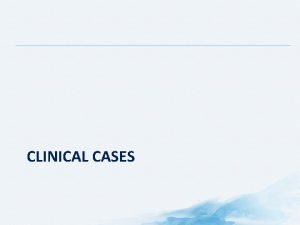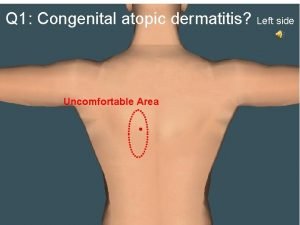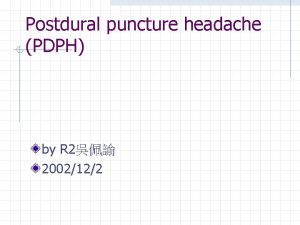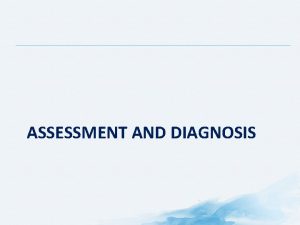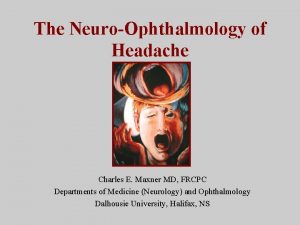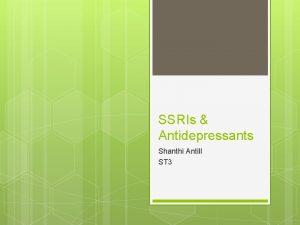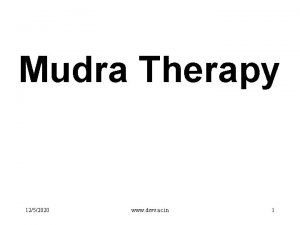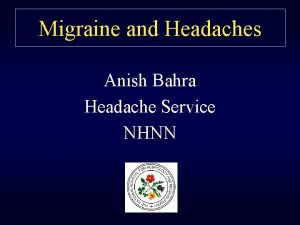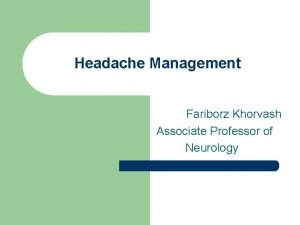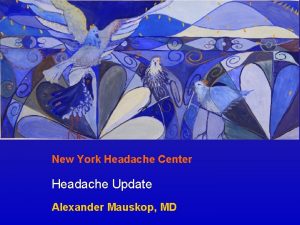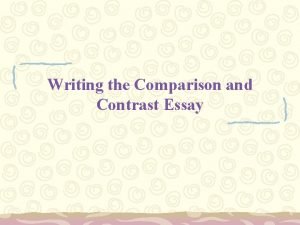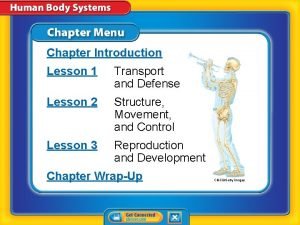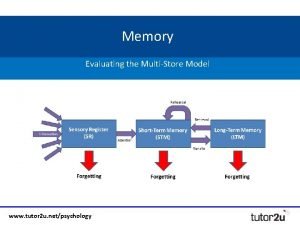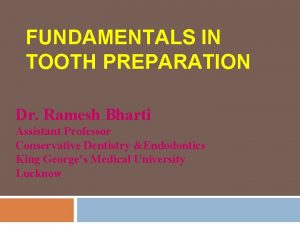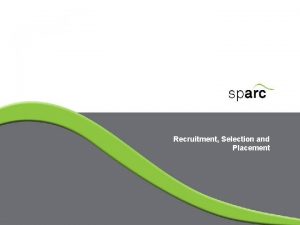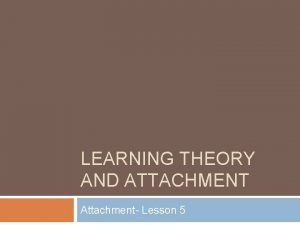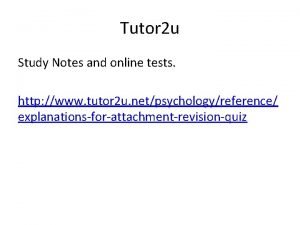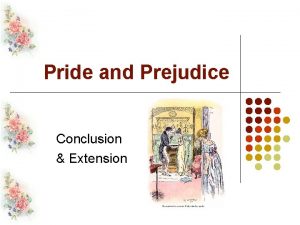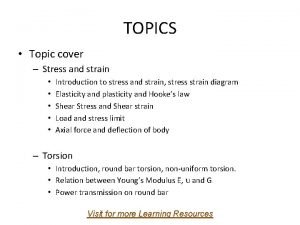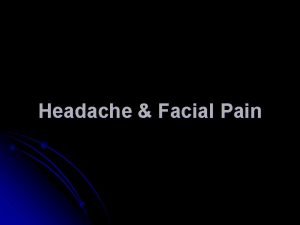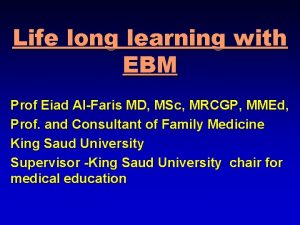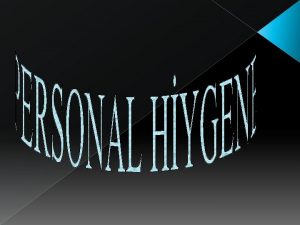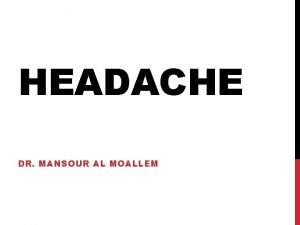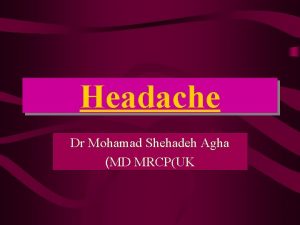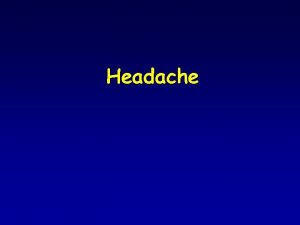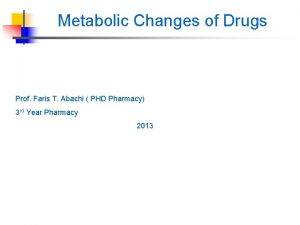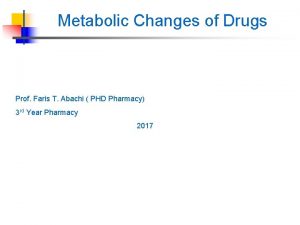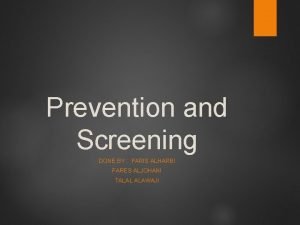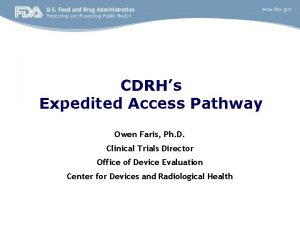Prof Eiad Al Faris 1 Outline Headache and

























































- Slides: 57

Prof Eiad Al Faris 1

Outline • Headache and its types • Misconceptions • Diagnostic approach • Differential diagnosis • Urgency considerations 2

Background: Headache…… -is among the most common medical complaints. -is one of the most common neurological problems presented to Family physicians and neurologists. Almost half (50%) of the adult population have had a headache at least once within the last year. (http: //www. who. int/mediacentre/factsheets/fs 277/en/) 3

What are the 2 categories of headache classification? 4

Types of headaches? 5

Types of headaches PRIMARY SECONDARY • Migraine • Tension type • Medication overuse headache • Benign exertional headache • Cluster • Other trigeminal autonomic cephalalgias • Space-occupying mass • Vascular lesion • Infection • Metabolic disturbance • Systemic problem. 6

What are the most common and the 2 nd most common types of primary headaches? 7

Guideline for primary care management of headache in adults. Canadian Family Physician • Headache on 15 or more days every month affects 1. 7– 4% of the world’s adult population • The lifetime prevalence is 66%: • Tension-type headache • Migraine • Cluster headache 46% to 78% 14% to 16% 0. 1% to 0. 3% 8

Learning objectives • The best approach to diagnose patients with headache. • Best practice for migraine prophylaxis. • Treating tension / cluster headaches. • Patient education 9

Misconceptions uptodate • Acute or chronic sinusitis appears to be an uncommon cause of recurrent headaches, and many pts turn out to have migraine. • Patients frequently attribute headaches to eye strain. A study suggested that headaches are only rarely due to refractive error alone. • Nevertheless, correcting vision may improve headache symptoms in some of these patients. • Hypertension cause headaches in case of HTN emergencies but not true for typical migraine or tension headaches. 10

Case scenario 1 11

Ahmed is a 14 -year-old boy. He attends your clinic accompanied by his mother. He presents with a two months history of headaches that he describes as “banging” and that make his head “very sore”. He says that in the past two months, he has had 6 of these headaches. He also says that light hurts his eyes when he has the headaches. He does not feel nauseous or vomit during the headaches. 12

Mother tells you that when Ahmed has the headaches, he is unable to go to school and that the headaches last from 2 to 4 hours. She gives Ahmed paracetamol and if that doesn’t work she also gives him ibuprofen. This combination of medication helps. What is the most likely diagnosis? With or without 13

14

MIDAS SCALE FOR MIGRAINE DISABILITY 15

Oxford handbook of general practice 16

How would you manage this pt? • Reassure: a serious underlying cause is unlikely • Migraines are a well-recognised problem • what causes them is not known for certain • Explain the risk of medication overuse headache 17

For acute management of migraine Pt preference, comorbidities and risk of adverse events. First line: Simple analgesics ( Ibuprofen 400 mg, ASA 1000 mg, naproxen sodium 500 -550 mg, acetaminophen 1000 mg ) Second line: Triptans 18

uptodate Mild to moderate attacks — not associated with vomiting - simple analgesics (NSAIDs, acetaminophen) or combination analgesics • Moderate to severe attacks — not associated with vomiting -oral migraine-specific agents are first-line, including oral triptans and the combination of sumatriptan-naproxen. • When complicated by vomiting , non oral migraine-specific medications including subcutaneous sumatriptan OR nasal sumatriptan, non oral antiemetic agents 19

Migraine lifestyle and triggers to avoid: • Irregular or skipped meals • Irregular or too little sleep • A stressful lifestyle • Excessive caffeine consumption • Lack of exercise • Obesity “Guideline for primary care management of headache in adults. Canadian Family Physician” 20

Managing patients with migraine cont…. • Encourage patients to participate actively in their treatment: -self-monitoring to identify factors influencing migraine -maintaining a lifestyle that does not worsen migraine -practicing relaxation techniques -maintaining good sleep hygiene -using cognitive behavioral therapy (CBT)to avoid negative thinking -improving communication skills to talk effectively about pain with family and others -using acute and prophylactic medication appropriately 21

Case scenario 2 22

• Aliya is a 28 -year-old woman who was diagnosed with migraine with aura 6 months ago. She has, on average, 1 migraine attack per week, for which she takes an NSAID and an anti-emetic. • Because Aliya has migraine about 4 times per month, she is unlikely to develop medication overuse headache. You are therefore happy with her current treatment plan. • However, during an attack, she is unable to work or continue her normal daily activities. She also worries a lot about when the next attack is going to happen and their frequency causes her to take a lot of time off work. 23

• You want to confirm that she is not a taking combined hormonal contraceptive for contraception purposes. Why? • The Centers for Disease Control and Prevention (CDC), 2017 (medical eligibility criteria) recommends that the combined hormonal contraception should not be used in women with migraine with aura at any age. • There is an increased risk of ischaemic stroke in people with migraine with aura. This risk is increased in women using combined hormonal contraception. 24

You suggest propranolol for migraine prophylaxis. a) How would you assess the effectiveness of the propranolol? Headache diary b) When would you review the need to continue this prophylaxis? -It might take 4 -8 wk for substantial benefit to occur -If the prophylactic drug provides substantial benefit in the first 2 mo of therapy, this benefit might increase further over several additional months of therapy 6 -12 months after the start of prophylactic treatment. Headaches in over 12 s: diagnosis and management (2012 updated 2015) Guideline for primary care management of headache in adults Canadian Family Physician 25

She wants to become pregnant in the future, but still needs migraine prophylaxis, what should you do? 26

She wants to become pregnant in the future, but still needs migraine prophylaxis, what should you do? • Migraine without aura often improves during pregnancy. However, migraine with aura is more likely to continue throughout pregnancy. • Seek specialist advice if prophylactic treatment for migraine is needed during pregnancy. • Offer pregnant women paracetamol for the acute treatment of migraine. Headaches in over 12 s: diagnosis and management (2012 updated 2015) 27

Case scenario 3 28

Abdullah is a 31 -year-old man. He has a history of severe headaches, which are the worst pain he has ever felt. When he gets these headaches, he has pain on one side of his head, around his eye and along the side of his face. He also experiences watery eye and nasal congestion, on the same side as the headache. He experienced the headache for the first time two weeks ago. The CT scan done was normal and you have been asked to evaluate him. He tells you that, since his first severe headache 2 weeks ago, he has experienced 6 more headaches. He says that on average his severe headaches last from 30 to 90 minutes. 29

What advice and support can you offer about his diagnosis? • Management primarily pharmacologic • Offer O 2 or a subcutaneous or nasal triptan for the acute treatment. • What prophylaxis for cluster headache could you offer him? • Prophylactic medication: consider offering him verapamil. • Seek specialist advice before starting verapamil • Early specialist referral recommended Guideline for primary care management of headache in adults, Canadian Family Physician 30

What medications would you not offer for the acute management of his cluster headache attacks? • You would not offer paracetamol, NSAIDS, or opioids as there is no evidence to suggest that they would have any clinical benefit in the treatment of cluster headache. NICE: https: //www. nice. org. uk/donotdo/do-not-offer-paracetamol-nsaids-opioids-ergots-or-oral-triptans-for-the-acutetreatment-of-cluster-headache https: //www. uptodate. com/contents/cluster-headache-treatment-andprognosis? search=cluster%20 headache%20 prophylaxis&source=search_result&selected. Title=1~65&usage_type=default&display_rank=1#H 5 31

Practice points for primary headache • Rule out secondary headache (Space-occupying mass, heamorrhage, Infection). • Imaging is not recommended for the routine assessment of patients with headache with normal neurologic examination findings, and no red flags. • History and physical examination findings are usually sufficient to make a diagnosis • Migraine should be considered in patients with recurrent moderate or severe headaches and normal neurologic examination findings Guideline for primary care management of headache in adults, Canadian Family Physician 32

General practice points cont…. • Consider a diagnosis of migraine in patients with a previous diagnosis of recurring “sinus” headache. • Medication overuse is considered when patients with migraine or tension-type headache use combination analgesics, • Opioids, or triptans on ≥ 10 d/mo or • Acetaminophen or NSAIDs on ≥ 15 d/mo • Comprehensive migraine therapy includes management of lifestyle factors and triggers, acute and prophylactic medications, and migraine self-management strategies 33

Systemic symptoms SNOOP( red flag signs) Neurologic symptoms Onset Other associated conditions Previous headache history fever, weight loss, cancer, pregnancy, immunocompromised state confusion, impaired alertness, papilledema, neurologic signs, meningismus, or seizures Age >40 years, or sudden "thunderclap“ Head trauma, headache awakens from sleep, worse with Valsalva maneuvers. Progression or change in attack frequency, severity 34

Characteristics of migraine, tension-type, and cluster headache syndromes Symptom Migraine Tension-type Location Adults: Unilateral in 60 to 70 percent, Children and adolescents: Bilateral in Bilateral majority Characteristics Gradual in onset, crescendo pattern; pulsating; moderate or severe intensity; aggravated by routine physical activity Cluster Always unilateral, usually begins around the eye or temple Patient appearance Pain begins quickly, reaches a crescendo within minutes; Pressure or tightness which pain is deep, continuous, waxes and wanes excruciating, and explosive in quality Patient prefers to rest in a dark, quiet Patient may remain active Patient remains active room or may need to rest Duration 4 to 72 hours Associated symptoms Nausea, vomiting, photophobia, phonophobia; may have aura 30 minutes to 7 days 15 minutes to 3 hours None Ipsilateral lacrimation, redness of the eye; stuffy nose; rhinorrhea; pallor; sweating; Horner syndrome 35

Important elements in history : headache for the first time or those with a change in headache pattern 37

Important elements in history : headache for the first time or those with a change in headache pattern Explore the following important elements : • Headache onset (thunderclap, head or neck trauma) • previous attacks (progression of symptoms) • duration of attacks (4 hours, continuous) • days per month with headache • Pain location • associated symptoms • Relationship to precipitating factors (stress, posture etc) • Effect on work and family activities • Response to acute and preventive medications • Presence of coexistent conditions (depression, asthma, etc) 38

Approach to the physical examination 39

Approach to the physical examination • Blood pressure & temp measurement • Screening neurologic examination • Neck examination • If indicated, a focused neurologic examination • If indicated by associated jaw complaints, an examination for temporo-mandibular disorders 40

Red flags and other potential indicators of secondary headache 41

42

Red flags Emergent (address immediately) • Thunderclap onset • Fever and meningismus • Papilledema with focal signs or reduced LOC • Acute glaucoma Urgent (address within hours to days) Guideline for primary care management of headache in adults, Canadian Family Physician • Temporal arteritis • Papilledema (WITHOUT focal signs or reduced LOC) • Relevant systemic illness • Elderly patient: new headache with cognitive change yes Possible indicators of secondary headache • • Refer and investigate Unexplained focal signs Atypical headaches Unusual aura symptoms Onset after age 50 y Aggravation by neck movement • Abnormal neck examination findings (cervicogenic headache) • Jaw symptoms (consider temporomandibular joint disorder) 43

Headache with ≥ 2 of • Nausea • Light sensitivity • Interference with activities migraine NO Headache with no nausea but ≥ 2 of • Bilateral headache • Non pulsating pain • Mild to moderate pain • Not worsened by activity Tension type headache 44

Medication overuse Assess • Ergots, triptans, combination analgesics, or codeine ≥ 10 d/mo OR • Acetaminophen or NSAIDs ≥ 15 d/mo Manage • Educate patient • Consider prophylactic medication • Provide an effective acute medication for severe attacks • Gradual withdrawal of opioids if used • Abrupt (or gradual) withdrawal of acetaminophen, NSAIDs, or triptans 45

Diagnosing primary headache syndromes 46

47

Acute Migraine Medication First line Ibuprofen 400 mg ASA 1000 mg naproxen sodium 500 -550 mg acetaminophen 1000 mg Second line • Triptans: oral sumatriptan 100 mg • Subcutaneous sumatriptan 6 mg if the patient is vomiting early in the attack. • Nasal spray: sumatriptan 20 mg if patient is nauseated Antiemetics: domperidone 10 mg or metoclopramide 10 mg for nausea Third line Naproxen sodium 500 -550 mg in combination with a triptan Fourth line Fixed-dose combination analgesics (with codeine if necessary; not recommended for routine use 48

Prophylactic Medications Prophylactic MEdications Starting dose Titration, * daily Dose increase Target dose or therapeutic range First line propranolol 20 mg twice daily 40 mg/wk 40 -120 mg twice daily metoprolol 50 mg twice daily 50 mg/wk 50 -100 mg twice daily amitriptyline 10 mg at bedtime 10 mg/wk 10 -100 mg at bedtime Second line Topiramate 25 mg/d 25 mg/wk 50 mg twice daily candesartan 8 mg/d 8 mg/wk Few side effects; limited experience in prophylaxis gabapentin 300 mg/d 300 mg every 3 -7 d Few drug interactions 49

Medications for tension-type headache Medication Dose Acute Ibuprofen ASA Naproxen sodium Acetaminophen 400 mg 1000 mg 500 -550 mg 1000 mg Prophylactic First line amitriptyline nortriptyline 10 -100 mg/d Second line • mirtazapine • venlafaxine 30 mg/d 150 mg/d 50

Chronic headache 51

• Aliya asks if there is anything that can be done to reduce the frequency of her migraine attacks. • Explain that prophylactic treatments prevent, rather than cure, a condition. • Depending on the person’s clinical needs and their preferences • offer prophylaxis with propranolol • consider treatment with amitriptyline 52

Medication overuse headache (MOH) • Also called analgesic rebound headache • Consider a diagnosis in patients with • headache on ≥ 15 d/mo • possible medication overuse • use of triptans, ergots, combination analgesics, or opioid-containing medications on ≥ 10 d/mo, or • use of acetaminophen or NSAIDs on ≥ 15 d/mo • Highest with opioids containing combination analgesics, and aspirin/acetaminophen/caffeine combinations. • Intermediate with triptans • Lowest with NSAIDs 53

Coping strategies for headache • patients with suspected medication overuse might benefit from selfmanagement strategies: • (eg, identification and management of controllable headache triggers, relaxation exercises, effective stress management skills, and activity pacing) • Headache diaries that record acute medication intake are important in the prevention and treatment of medication-overuse headache 55

Prophylactic medication • Educate patients on the need to take the medication daily and according to the prescribed frequency and dosage • Ensure that patients have realistic expectations, Explain that… -Headache attacks will likely not be abolished completely -A reduction in headache frequency of 50% is usually considered worthwhile and successful -It might take 4 -8 weeks for substantial benefit to occur -If the prophylactic drug provides a substantial benefit in the first 2 mo of therapy, this benefit might increase further over several additional months of therapy • Evaluate the effectiveness of therapy using patient diaries 60

Prescribing prophylactic medication cont • For most prophylactic drugs, initiate therapy with a low dose and increase the dosage gradually to minimize side effects • Increase the dose until the drug proves effective, until dose limiting side effects occur, or until a target dose is reached • Continue the prophylactic drug for at least 6 -8 wk after dose titration is completed • Because migraine attack tendency fluctuates over time, consider gradual discontinuation of the drug for many patients after 6 to 12 mo of successful prophylactic therapy 61

Management of MOH- Patient education. • Acute medication overuse can increase headache frequency • When medication overuse is stopped, headache might worsen temporarily and other withdrawal symptoms might occur • Many patients will experience a long-term reduction in headache frequency after medication overuse is stopped • Prophylactic medications might become more effective 62

Special thanks to Prof. Eiad Al. Faris for providing the materials for this TBL 64
 Peter faris
Peter faris Bismillahir rahmanir rahim alhamdulillahi rabbil alamin
Bismillahir rahmanir rahim alhamdulillahi rabbil alamin Wikipedia sidney crosby
Wikipedia sidney crosby Perbandingan uang rahmat dan uang faris
Perbandingan uang rahmat dan uang faris Tyhn
Tyhn Rasmussen syndrome
Rasmussen syndrome Headache red flags
Headache red flags Sick leave policy in infosys
Sick leave policy in infosys Headache pain chart
Headache pain chart Headache red flags
Headache red flags Right side headache
Right side headache Pumcture
Pumcture Snoop headache criteria
Snoop headache criteria Headache after migraine
Headache after migraine Ophthalmoplegic migraine
Ophthalmoplegic migraine Headache
Headache Anxiety headache
Anxiety headache Postictal state
Postictal state Spina bifida occulta
Spina bifida occulta Aditya mudra
Aditya mudra Headache
Headache Dix hallpike
Dix hallpike Red flag sign headache
Red flag sign headache Headache
Headache ı have a headache song
ı have a headache song Mauskop
Mauskop Headache
Headache European headache federation
European headache federation Quote sandwich format
Quote sandwich format Growth and development conclusion
Growth and development conclusion Prof ram meghe institute of technology and research
Prof ram meghe institute of technology and research Comparison and contrast outline
Comparison and contrast outline Outline and evaluate the cognitive approach
Outline and evaluate the cognitive approach Support control and movement lesson outline
Support control and movement lesson outline Lesson outline magnets and magnetic fields answer key
Lesson outline magnets and magnetic fields answer key Antarctica outline map
Antarctica outline map Occupational health and safety assessment series
Occupational health and safety assessment series Compare and contrast essay outline
Compare and contrast essay outline Transport and defense lesson 1 answer key
Transport and defense lesson 1 answer key Structure movement and control answer key
Structure movement and control answer key World wide web introduction
World wide web introduction Parallel and distributed computing syllabus
Parallel and distributed computing syllabus Tutor 2 u psychology
Tutor 2 u psychology Outline main idea and supporting details
Outline main idea and supporting details Epq spec
Epq spec Initial depth and outline form
Initial depth and outline form What is functionalism sociology
What is functionalism sociology Occupational health and safety course outline
Occupational health and safety course outline Lesson outline lesson 1 solids liquids and gases answer key
Lesson outline lesson 1 solids liquids and gases answer key What are the advantages and disadvantages of essay writing
What are the advantages and disadvantages of essay writing Recruitment selection and placement process
Recruitment selection and placement process Learning theory attachment
Learning theory attachment Outline and evaluate bowlby's monotropic theory 8 marks
Outline and evaluate bowlby's monotropic theory 8 marks Conclusion of prejudice
Conclusion of prejudice Electric charges and electric forces lesson outline
Electric charges and electric forces lesson outline Stress and strain reading outline
Stress and strain reading outline Exploratory research example
Exploratory research example Outline meaning and examples
Outline meaning and examples
